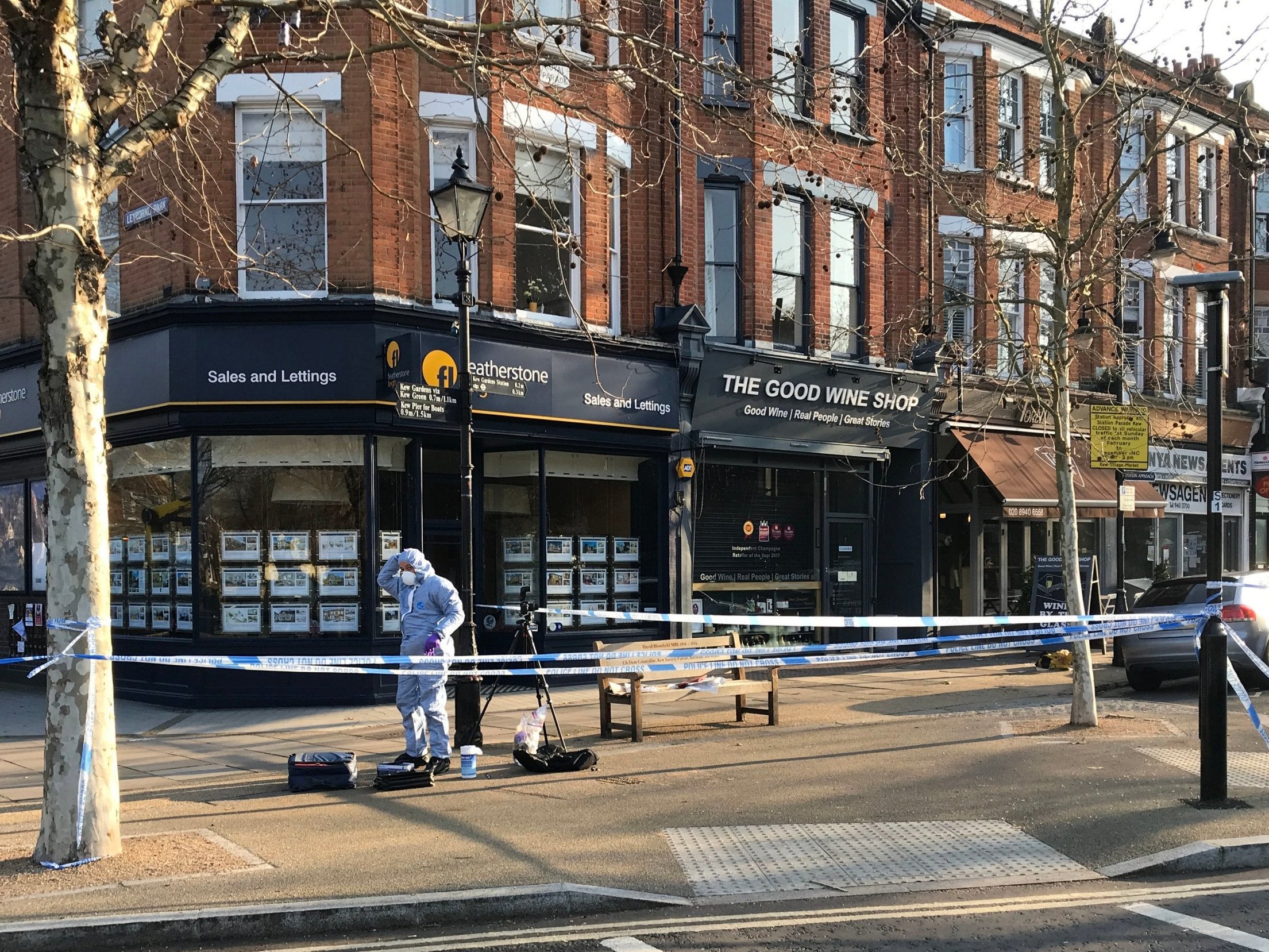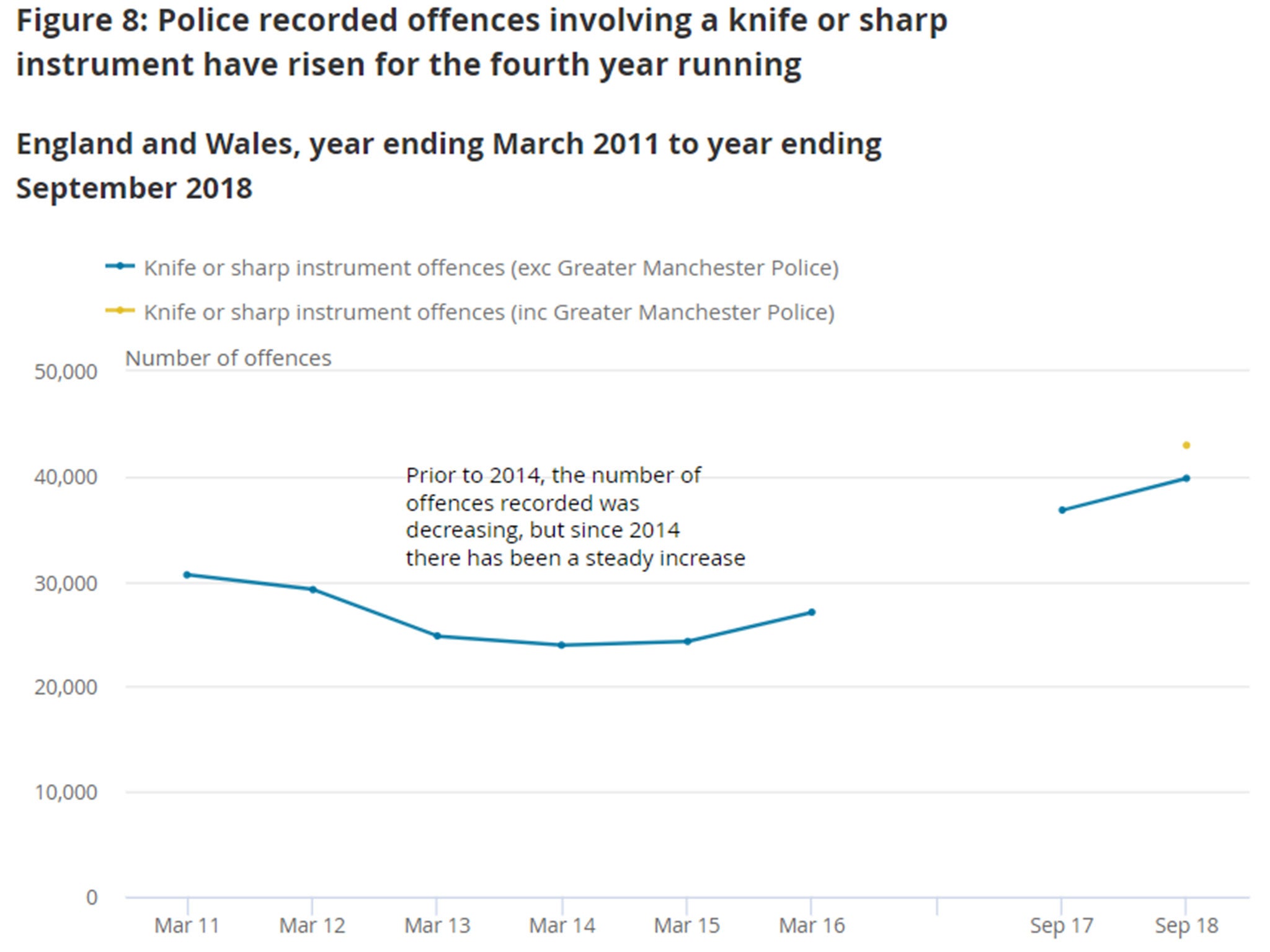Crimes using bladed weapons at highest level for eight years, say police
Homicides rise by 14% to 739 killings in England and Wales

Crimes involving knives or sharp weapons have hit the highest level since 2011, new figures show.
For the year to September, homicides also rose by 14 per cent to 739 killings in England and Wales.
In the same period, almost 43,000 knife or sharp weapons offences were recorded by police, an 8 per cent rise year-on-year.
“This is the highest number since the year ending March 2011,” the Office for National Statistics (ONS) said.
“The past four years have seen a rise in the number of recorded offences involving a knife or sharp instrument, following an initial downward trend.”
Most offences using knives were assault, followed by robbery, threats to kill, rape, attempted murder, homicide and sex attacks, and there was a 15 per cent rise in hospital admissions for stab wounds.
It comes amid a 7 per cent rise in overall police-recorded crime, with a total of 5,723,182 offences in the year.
It is the highest number in a 12-month period since the year ending March 2004, when there were 6.01 million offences recorded.
Violence rose 19 per cent in the year and homicide was up by 14 per cent, according to police records.
There was also a 14 per cent rise in sexual offences, but the ONS said the figure was “likely to reflect improvements made by the police in how they record crime, and in people being more willing to report a sexual offence”.
Helen Ross, of the ONS Centre for Crime and Justice, said: “In recent decades we’ve seen the overall level of crime falling, but in the last year, it remained level. There are variations within this overall figure, depending on the type of crime.
“Burglary, shoplifting and computer misuse are decreasing but others, such as vehicle offences and robbery, are rising. We have also seen increases in some types of ‘lower-volume, high-harm’ violence including offences involving knives or sharp instruments.”
The ONS said the homicide figure was calculated excluding the 36 victims of 2017’s terror attacks in London and Manchester, in order to provide a more accurate picture of underlying trends.
The figures come amid continued public concern over rising violence, following a spate of bloody street attacks.
The killing of 14-year-old Jayden Moodie in London sparked national calls for action this month, and police have warned of a rising number of children carrying knives in the belief it will protect them.
Senior officials have said a “lost generation” is being created by austerity, violence and the “county lines” drug dealing that sees teenagers used as mules and dealers.
Alex Mayes, policy adviser at Victim Support, said the impact on families has been “particularly felt in larger cities where many of these rises are being driven by knife crime and we’ve witnessed firsthand the devastation caused”.

“Too many families and communities are being shattered by these crimes and we must focus on a joined-up approach with all agencies and organisations taking responsibility to tackle this together,” he added.
Diane Abbott, Labour’s shadow home secretary, said the figures show the “failures of government policy”.
“The Tories have cut police officer numbers. They have also exacerbated all the causes of crime, including inequality, poverty, poor mental-health care as well the crisis in our schools, especially school exclusions,” she added.
Police leaders have been pushing the government to inject more funding into forces across the country, following the loss of more than 20,000 officers since the coalition came into power nine years ago.
John Apter, chair of the Police Federation, said: “Society just isn’t as safe as it once was, and although the police service is doing everything within its power, we are swimming against the tide and it is the public who are being let down.”
Home Office statistics released on Thursday showed the first annual rise in the number of officers in England and Wales since 2009.
There were 466 more officers than the year ending September 2017, an increase of 0.4 per cent. But the rise was not seen in every force, with the Metropolitan Police, Thames Valley, South Yorkshire and Merseyside all losing officers.
As the figures were released, the mayor of London and Metropolitan Police announced plans to use £85m to tackle violent crime and burglary in the capital.

A statement said violence and stabbings had “begun to slow in London” but efforts would continue to take weapons off the streets and give young people more opportunities.
Sadiq Khan added: “The causes of violent crime are extremely complex and involve deep-seated problems … made much worse by huge government cuts to the police and preventative services.”
Chief Constable Bill Skelly, National Police Chiefs’ Council (NPCC) lead for crime statistics, said that while recording practices had improved, there had been “real rises in serious crimes”.
“Growing violent crime is not something that can be solved by policing alone,” he added.
“Rising crime, increased terrorist activity and fewer police officers have put serious strain on the policing we offer to the public.
“We are determining the additional capabilities and investment we need to drive down violence and catch more criminals – and we will make the case at the next government spending review.”
Policing minister Nick Hurd said the 2019-20 police financial settlement would deliver up to £970m extra funding to recruit more officers – although almost £509m will be taken from council tax precept.
“Today’s statistics show that your chance of being a victim of crime remains low. But we accept certain crimes, particularly violent crime, have increased and we are doing everything possible to reverse the trend,” he added.
“We know it’s also crucial to stop crime happening in the first place. This is why our government’s Serious Violence Strategy emphasises intervening early and is working to prevent young people from being drawn into a life of crime.”
Bookmark popover
Removed from bookmarks